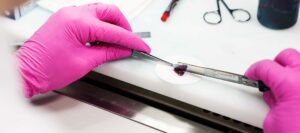Bin Ren et al. deal with the topic of artificial expression of bone material via adipose tissue cells in their scientific report in the scientific journal Nature, “Genes activated adipose tissue fragments as advanced autologous biomaterials for bone regeneration: osteogenic differentiation within the tissue and implications for clinical translation”. The basis for this is genetics. A specific gene, the so-called BMP-2, which is responsible for the formation of bone material, must first be integrated into the fat cells. This is done via adeno-associated viruses, which act as a smuggler of genetic material. Once in the cell nucleus, this strand is to be read with the BMP-2 and thus the desired molecule is to be produced, which later leads to bone formation. The presence of the molecule, the hBMP-2, was quantitatively checked by various optical tests.
„Cost-effective, expedited approaches for bone regeneration are urgently needed in an ageing population. Bone Morphogenetic Proteins (BMPs) stimulate osteogenesis but their efficacy is impeded by their short half-life. Delivery by genetically modified cells can overcome this problem. However, cell isolation and propagation represent significant obstacles for the translation into the clinic. Instead, complete gene activated fragments of adipose tissue hold great potential for bone repair. Here, using an in-vitro culture system, we investigated whether adenoviral transduction with human BMP-2 can promote osteogenic differentiation within adipose tissue fragments. Osteoinduction in adipose tissue fragments was evaluated by quantitative reverse transcriptase polymerase chain reaction, immunohistology and histomorphometry. BMP-2 transduced adipose tissue synthesized BMP-2 protein over 30 days peaking by day six, which significantly promoted osteogenic differentiation as indicated by increased calcium depositions, up-regulation of bone marker genes, and bone-related protein expression. Our results demonstrate that cells within adipose tissue fragments can differentiate osteogenically after BMP-2 transduction of cells on the surface of the adipose tissue. BMP-2 gene activated adipose tissue represents an advanced osteo-regenerative biomaterial that can actively contribute to osteogenesis and potentially enable the development of a novel, cost-effective, one-step surgical approach to bone repair without the need for cell isolation.“
Bin Ren et al.
What was the M8 used for?
Our M8 microscope was used in this process to take scans for histomorphometry and immunohistochemical staining.
Where can I find the publication?
If you want to read the entire publication, click on this link:
Gene activated adipose tissue fragments as advanced autologous biomaterials for bone regeneration: osteogenic differentiation within the tissue and implications for clinical translation











